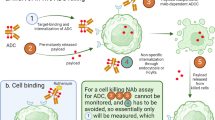Abstract
The bioanalytical strategy for monoclonal antibody therapeutics, intended for multiple oncology indications, includes multiple integrated measurements of pharmacologically relevant therapeutics from discovery through development. Three ligand binding assays were cohesively developed and validated, as applicable, using the Gyrolab microfluidic system for the measurement of a free monoclonal antibody BMS-986207. Accuracy and precision demonstrate %bias from −6.3 to 4.4%, percent coefficient of variation (%CV) from 2.6 to 9.8%, and total error from 4.2 to 13.4% in the nonclinical assay; %bias from −0.3 to 3.3%, %CV from 3.5 to 18.2%, and total error from 6.1 to 19.7% in the clinical assay; and >97% of the sample meeting incurred sample reanalysis criteria. The clinical assay was validated using singlicate wells after gaining significant data in the early phase studies to support this cost-effective and efficient strategy. Each assay met fit-for-purpose and/or regulated bioanalytical method validation criteria including stability, selectivity, dilutional linearity, carryover, and specificity criteria with no interference from co-administered monoclonal antibody.





Similar content being viewed by others
References
Dudal S, Baltrukonis D, Crisino R, Goyal M, Joyce A, Österlund K, et al. Assay formats: recommendation for best practices and harmonization from the global bioanalysis consortium harmonization team. AAPS J. 2014;16:194–205.
Clark TH, Yates PD, Chunyk AG, Joyce AP, Wu A, Pop-Damkov P, et al. Feasibility of singlet analysis for ligand binding assays: a retrospective examination of data generated using the Gyrolab platform. AAPS J. 2016;18:1300–8.
Chilewski SD, Mora JR, Gleason C, DeSilva B. Addressing matrix effects in ligand-binding assays through the use of new reagents and technology. Bioanalysis. 2014;6:1059–67.
Liu R, Hoffpauir B, Chilewski SD, Gamberdella J, Kavita U, Duo J, et al. Accelerating regulated bioanalysis for biotherapeutics: case examples using a microfluidic ligand binding assay platform. AAPS J. 2016; doi:10.1208/s12248-016-0006-z.
Liu R, Pillutla R, DeSilva B, Zhang YJ. Rapid development of multiple ‘fit-for-purpose’ assays on an automatic microfluidic system using a streamlined process in support of early biotherapeutics discovery programs. Bioanalysis. 2013;5:1751–63.
US Department of Health and Human Services, Food and Drug Administration, Center for Drug Evaluation and Research. Guidance for industry: bioanalytical method validation www.fda.gov/downloads/drugs/guidancecomplianceregulatoryinformation/guidances/ucm368107.pdf (2013). Accessed 23 May 2017.
European Medicines Agency. Guideline on bioanalytical method validation. www.ema.europa.eu/docs/en_GB/document_library/Scientific_guideline/2011/08/WC500109686.pdf (2011). Accessed 23 May 2017.
DeSilva B, Smith W, Weiner R, Kelley M, Smolec J, Lee B, et al. Recommendations for the bioanalytical method validation of ligand-binding assays to support pharmacokinetic assessments of macromolecules. Pharm Res. 2003;20:1885–900.
Lee JW, Kelley M, King LE, Yang J, Salimi-Moosavi H, Tang MT, et al. Bioanalytical approaches to quantify “total” and “free” therapeutic antibodies and their targets: technical challenges and PK/PD applications over the course of drug development. AAPS J. 2011;13:99–110.
Acknowledgements
The authors would like to thank Robert Dodge, Huijin Dong, Donata David-Brown, and the BMS Bioanalytical Sciences Scientific Advisory Board for their review and technical contributions to this manuscript.
Author information
Authors and Affiliations
Corresponding authors
Ethics declarations
Animal experiments were conducted in full compliance with local, national, ethical, and regulatory principles and local licensing regulations, per the spirit of the Association for Assessment and Accreditation of Laboratory Animal Care (AAALAC) International’s expectations for animal care and use/ethics committees.
Rights and permissions
About this article
Cite this article
Jiang, H., Kozhich, A., Cummings, J. et al. Singlicate Ligand Binding Assay Using an Automated Microfluidic System: a Clinical Case Study. AAPS J 19, 1461–1468 (2017). https://doi.org/10.1208/s12248-017-0105-5
Received:
Accepted:
Published:
Issue Date:
DOI: https://doi.org/10.1208/s12248-017-0105-5




